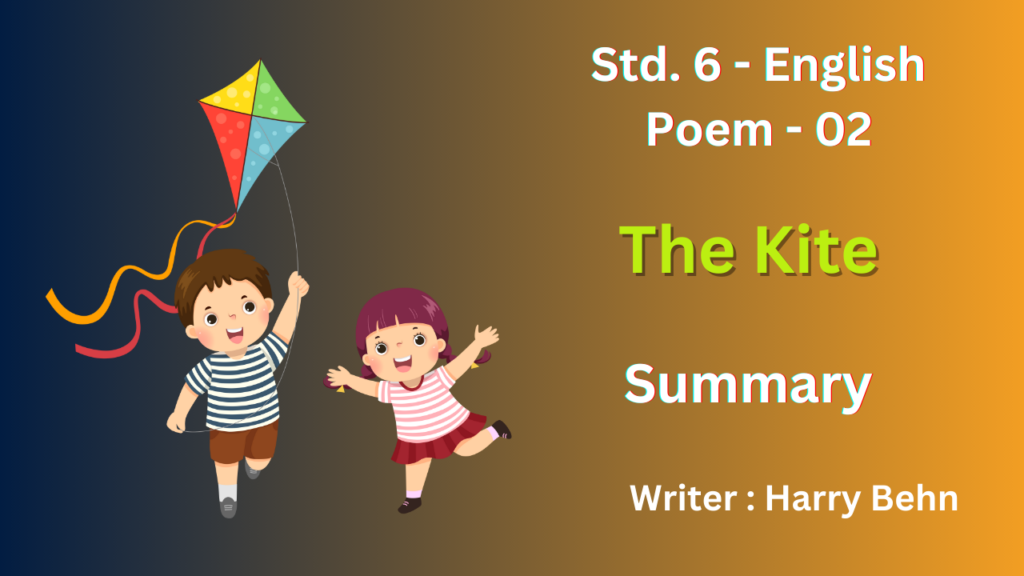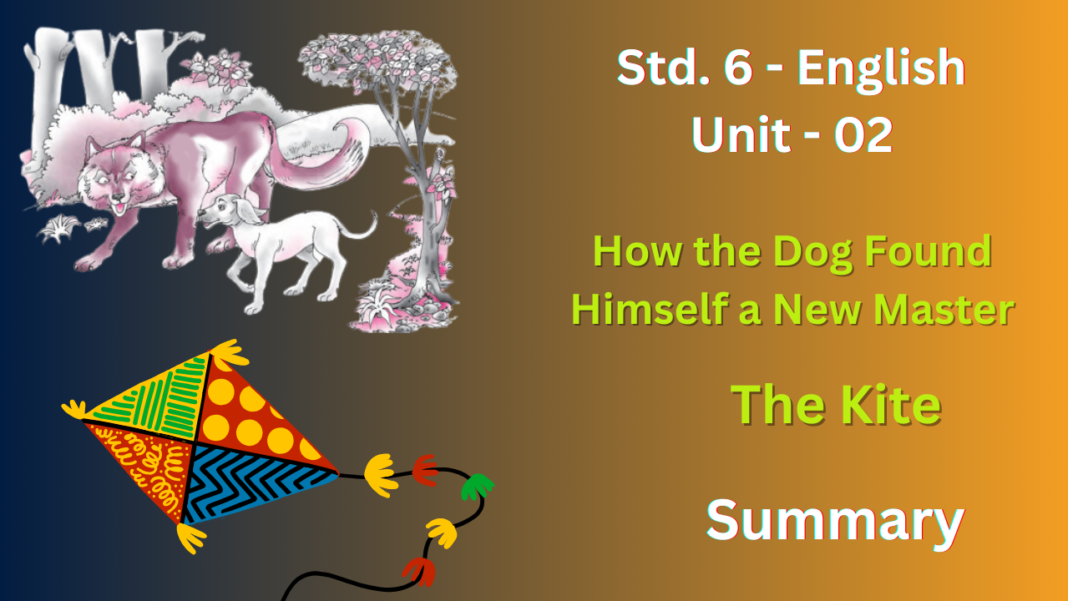NCERT Solutions for Class 6th English Chapter 2: How the Dog Found Himself
How the Dog Found Himself a New Master
The chapter “How the Dog Found Himself a New Master” tells the story of a dog who searches for the strongest master. Here’s a breakdown of the key points:
- The Dog’s Discontent: The story starts with a dog who dislikes being alone and vulnerable. He wants a powerful master to protect him.
- A Series of Masters:
- The dog first chooses a wolf, but seeing the wolf fear a bear, he leaves to find a stronger protector.
- He then chooses the bear, only to witness the bear’s fear of a lion.
- The Lion’s Reign: The dog finally chooses the lion, believing him to be the strongest. He enjoys a secure life under the lion’s protection.
- The Unexpected Turn: One day, the lion encounters a man and shows fear.
- A New Master Revealed: The dog realizes that man is the most powerful and chooses to serve humans from that point on.
The Underlying Message:
The story uses a lighthearted approach to convey the idea that strength can come in many forms. While physical power is important, humans, with their intelligence and tools, are ultimately seen as the dominant force.
WORKING WITH THE TEXT
A. Discuss these questions in pairs before you write the answers.
1. Why did the dog feel the need for a master?
Ans :
- Vulnerability and Fear of Being Alone: The text mentions the dog disliked being on his own. He felt exposed and afraid (possibly of stronger animals or the unknown). This fear of being alone motivated him to find a master for protection.
- Desire for a Strong Protector: The dog specifically sought a “stronger” master (mentioned in the second paragraph). This suggests he didn’t just want companionship, but a powerful guardian who could ensure his safety and well-being.
2. Who did he first choose as his master? Why did he leave that master?
Ans : The dog first chose a wolf as his master. However, he soon left the wolf for a reason the reason is that
The Wolf’s Fear: The dog witnessed the wolf fearing a bear.
3. Who did he choose next?
Ans : After leaving the wolf, the dog chose the bear as his next master. The dog’s logic was that the bear’s size and perceived ferocity made it a stronger protector than the wolf.
4. Why did he serve the Lion for a long time? (8)
Ans : The dog served the lion for a long time for a combination of reasons explained in the story:
- Undisputed Strength and Security: The dog viewed the lion as the strongest animal he had encountered. The lion’s size, power, and reputation as the king of the jungle convinced the dog he had finally found a master who could guarantee his safety.
- Comfort and Protection: Under the lion’s protection, the dog enjoyed a comfortable and secure life. The lion’s dominance ensured the dog wouldn’t be threatened by other animals. This sense of security likely solidified the dog’s decision to stay with the lion.
- Lack of Encounter with Humans: Up to this point, the dog hadn’t encountered a human, the true holder of power according to the story. Without this knowledge, he believed the lion represented the ultimate form of strength.
5. Who did he finally choose as his master and why?
Ans : The dog finally chose a man as his master, and the reason is
- Humans and Strength: The dog concluded that humans, with their intelligence and tools, were the most powerful beings he had encountered. He recognized their dominance and believed they offered superior protection compared to the animals.
B. A summary of the story is given below. Fill in the blanks to complete it taking appropriate phrases from the box.
[ a dog , stronger than anyone else , the strongest of all , a wolf , the bear, afraid of man , his own master , a lion ]
This is the story of ______, who used to be______. He decided to find a master______. First he found_____, but the wolf was afraid of_______. The dog thought that the bear was________. After some time the dog met_____ , who seemed the strongest. He stayed with the lion for a long time. One day he realised that the lion was_______. To this day, the dog remains man’s best friend.
Ans :
- be his own master
- stronger than anyone else.
- a wolf
- the bear.
- the strongest of all.
- a lion,
- afraid of man.
WORKING WITH LANGUAGE
A. Each word in the box given below indicates a large number of… For example, a herd of cows’ refers to many cows. Complete each of the following phrases with from the box.
[ school , fleet , brood , bundle , bunch , peak , flock , herd ]
herd
1. a______of ships
2. a______of flowers
3. a______of chicks
4. a______of cattle
5. a______of sticks
6. a______of sheep
7. a______of fish
8. a_____of wolves
Ans :
- a fleet of ships
- a bunch of flowers
- a brood of chicks
- a herd of cattle
- a bundle of sticks
- a flock of sheep
- a school of fish
- a pack of wolves
B. Make nouns from the words given below by adding -ness or – ity. (For some words we need to add just -ty, or -y.)
1. Honest 2. Kind
3. Cruel 4. Calm
5. Sad 6. Active
7.creative 8.Sincere
9. Cheerful 10.Bitter
11. Sensitive 12. Great
Ans :
- Honest – Honesty
- Kind – Kindness
- Cruel – Cruelty
- Calm – Calmness
- Sad – Sadness
- Active – Activity
- Creative – Creativity
- Sincere – Sincerity
- Cheerful – Cheerfulness
- Bitter – Bitterness
- Sensitive – Sensitivity
- Great – Greatness
C. Wordsearch
• There are twelve words hidden in this table.
• Six can be found horizontally and the remaining six vertically.
• All of them are describing words like ‘good’, ‘happy’, etc.
•The first letters of the words are given below:
Horizontal : H R F F S G
Vertical: A W S F L Q
Ans : Horizontal words:
1. Hasty
2.ready
3. Fierce
4.Frightened
5.strong
6.good
Vertical Words:
1.Angry
2.Worse
3.Surprised
4.Free
5. Loyal
Poem – The Kite
NCERT Solutions for Class 6th English Poem 2 The Kite
The poem “The Kite” describes the joy and wonder of flying a kite on a clear day. Here’s a summary of the key points:
- Setting and Appearance: The kite is a beautiful sight against the clear blue sky, free from clouds.
- Movement and Comparison: The poem describes the kite’s movement as it dives, dips, and soars gracefully in the wind. It’s compared to a ship sailing the waves, emphasizing its smooth and effortless movement.
- Dependence on Wind: The poem highlights the dependence of the kite on the wind. When the wind weakens, the kite seems to rest, and the string goes slack. But a strong breeze allows the kite to rise even higher.
- The String’s Role: The string acts as a connection between the kite flyer and the kite itself. The person controls the kite by pulling and releasing the string.
- Fading Beauty: The poem hints at the impermanence of the kite’s flight. There’s a suggestion that the kite might get damaged or lost (perhaps by getting tangled in a tree).

WORKING WITH THE POEM
1. List out the action words in the poem.
dive, dip, snaps,_____, ______, ______, ________, _______ Find out the meanings of these words.
Ans : The action words in the poem “The Kite” are:
- dive – to move downwards quickly and suddenly
- dip – to move downwards and then upwards again quickly
- snaps – to break suddenly with a sharp sound (This likely refers to the sound of the string tightening or the kite flapping)
- soars – to fly smoothly and effortlessly in the air
- rides – to move smoothly on or in something, especially while being controlled by someone else
- climbs – to move upwards, especially using your hands and feet
- pulls – to move something towards you by force
- falls – to move downwards quickly and freely under the influence of gravity
2. Read these lines from the poem:
Then soars like a ship
With only a sail
The movement of the tailless kite is compared to a ship with a sail. This is called a simile. Can you suggest what or who the following actions may be compared to?
- He runs like______
- He eats like________
- She sings like______
- It shines like_______
- It flies like________
Ans :
- He runs like:
- A cheetah (if very fast)
- A bull in a china shop (if clumsy)
- The wind (if swift and effortless)
- He eats like:
- A horse (if fast and messy)
- A bird (if picking at small bites)
- A starving man (if eating quickly and a lot)
- She sings like:
- An angel (if beautiful and pure)
- A canary (if sweet and clear)
- A rockstar (if loud and energetic)
- It shines like:
- A diamond (if bright and sparkling)
- A beacon (if bright and guiding)
- The sun (if very bright and warm)
- It flies like:
- A butterfly (if graceful and delicate)
- An eagle (if powerful and majestic)
- A rocket (if fast and leaving a trail)
FAQ’S
How the dog found himself a new master lesson?
So the Dog went to ask the Lion to become his master. The Lion accepted, and the Dog remained with him, faithfully serving him for a considerable period. It was a content life, as there was no creature mightier than the Lion in the forest, ensuring the Dog’s safety and respect from others.
Where can I get the NCERT solutions of Unit 2 English Class 6 Honeysuckle?
To get NCERT solutions for unit 2 click on education85. Education85 provide all the questions and answers for all subject.
Why did the dog leave wolf?
Observing the Wolf’s fear of the Bear, the Dog decided to leave his timid master and align himself with the Bear instead.
What is the storyline of the chapter “How the Dog Found Himself”?
“How the Dog Found Himself” narrates the journey of a dog seeking a master, eventually finding one in the Lion, and later switching allegiance to the Bear.
How does the poem “The Kite” evoke emotions and imagery?
“The Kite” employs vivid imagery and sensory language to evoke feelings of excitement and freedom associated with flying a kite, engaging readers in a sensory experience.










